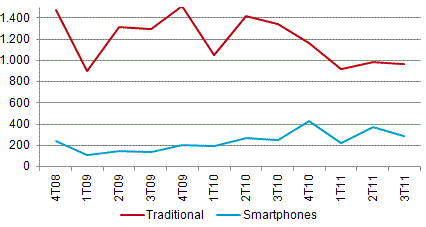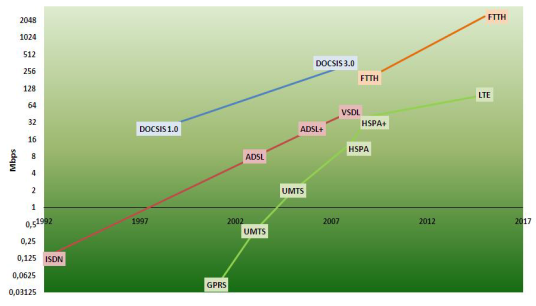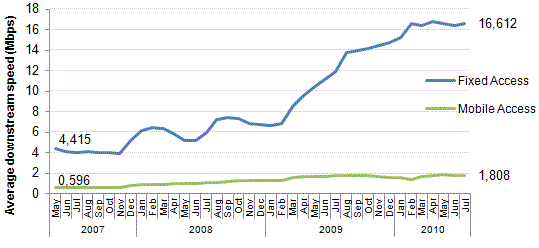The fast technological, economic and social development that we have observed has affected consumers' preferences and expectations with respect to services, especially Internet access service. So traditional phones and computers (both fixed and mobile), for example, are tending to become less attractive in comparison to new equipment or portable devices such as PDAs, smartphones or mp4 readers. One example is the increase in the relative weight of smartphones in the volume of mobile phone sales (see Figure 1).
Figure 1 - Selling of traditional mobile phones and smartphones,
between the end of 2008 and the third quarter of 2011

Volume of Equipment (Thousands). Source: IDC, Portugal.
These new trends are at the same time the cause and effect of the current convergence between fixed and mobile services, which enables the simultaneous use of several platforms and permits ubiquity between several types of access, i.e. makes it possible to make voice calls, watch television or videos, and access the Internet at the same time. The new retail offerings reflect this evolution.
Besides the new functionalities associated with the most recent and less traditional devices, other factors may be involved in the increased demand for them, such as:
a) The greater ease of access and simplicity carrying out certain activities compared with traditional devices. For example, some users may see a mobile phone (smartphone-type) that enables easier access to social networks as a better option than a traditional mobile phone;
b) The growing number of applications associated with mobile Internet access, especially access by mobile phones, which seem to promote mobile broadband usage at any time;
c) The ability and ease associated with device mobility - while in the past there was a tendency to replace desktop computers by laptops , currently their size and weight seem to be factors that are starting to gain more importance, so much so that sales of laptops 1has fallen, due not only to the current economic climate but also to the increasing demand for alternative, smaller, devices such as tablets, eBooks, and so forth;
d) The possibility of customizing the communication service and its access devices.
It is likely that, in the future, the electronic communications devices wanted by most users will be those that are easiest to use, with the possibility of customization, that provide a quick access to the functions and activities most often used by certain groups of users, and which are as small and lightweight as possible.
New mobile broadband offerings both via USB modem (stick) and by mobile phone reflect the advances in that service's access technologies. According to ICP-ANACOM (2011a), between 2009 and 2010 the number of mobile broadband offers for these two means increased from about 48 retail offers to over 70, and the maximum speed subscribed to increased from 21.6 Mbps to 41.3 Mbps. In ANACOM (2011a) there is a reference to the fact that mobile broadband offers via USB modem are differ considerably from mobile phone ones, especially in relation to the traffic offered.
Furthermore, in 2011 two 2 service providers offered a USB modem with the possibility of accessing 4G mobile broadband (LTE) and in 2012 one of these providers 3 now allows the pre-registration of 4G retail offers for private and business users.
These developments in mobile broadband, in terms of both platforms and speeds, have kept up with the development in fixed broadband. This technological evolution is shown in Figure 2, mentioned in ICP-ANACOM's study on the evolution of NGA (ICP-ANACOM, 2011b).
Figure 2 - Technological evolution of fixed and mobile access networks

Source: ICP-ANACOM (2011b),
This development can also be seen in the results of tests carried out by Internet users on Speedtest's website 4. According to the data obtained 5 by ICP-ANACOM from that company, between May 2007 and mid-July 2010 the average downstream speed of residential accesses to the Internet increased from 4.4 Mbps to 16.6 Mbps, and the average downstream speed for mobile accesses increased from 0.6 Mbps to 1.8 Mbps - see Figure 3.
This improvement, which translates into generally faster speeds, was recorded in all regions 6 and municipalities of Portugal, albeit not evenly, with a higher incidence in the coastal areas where there are larger populations and more competition.
Figure 3 - Average downstream speed (in Mbps) of residential fixed accesses and
mobile accesses (regardless of the means of access) to the internet

Source: ICP-ANACOM, based on Ookla / Speedtest data.
Considering the recent technological developments in supply and demand, this study tries to understand trends in the way individuals access mobile internet, both via USB modem and by mobile phone, as well and how this usage is influenced by the simultaneous use of fixed access. Current satisfaction regarding the usage of mobile accesses and the intention to keep or give them up are also analyzed.
To achieve this, ICP-ANACOM conducted a survey on Portuguese residents aged 15 and over to obtain information on Internet usage habits for the following means of access: a) mobile access using a USB modem (stick); b) mobile access using a mobile phone; and c) fixed access.
The survey was aimed to understand the type of usage of the several means of mobile Internet access by the respondents, both where there is exclusive access and when the user has other means of Internet access. When the respondent has more than one means of access, the survey was able to establish the characteristics of usage in both cases.
Chapter 3 includes the factsheet of the survey that was designed and promoted by ICP-ANACOM and carried out by Spirituc - Investigação Aplicada, Lda. Chapter 4 presents the distribution of respondents by type of access(es) used for the Internet. Chapter 5 gives the results on Internet use, by means of access to it, and the reasons for choosing the service provider, the satisfaction with the means of access used, the intention to give up that access in the future, and the existence of other means of access in the past. Chapter 6 presents the findings when respondents were asked their opinion on mobile broadband using a USB modem, and how it compares to fixed broadband.
The main conclusions of the study are presented in chapter 7.
1 In the second quarter of 2011, according to IDC Portugal figures, about 83% of all computers sold were laptops. Information available at Venda de PCs Desce 21,2% em Portugal no Segundo Trimestre de 2011http://www.idc.pt/press/pr_2011-08-25.jsp.
2 The two service providers are TMN and Vodafone, and the price of the USB modem is about €159.9.
3 The service provider mentioned is Vodafone.
4 See Speedtest.nethttp://www.speedtest.net.
5 Information was acquired from Ookla, the company owning the Speedtest service, on the results of the tests - about 7.5 million - taken between 2006 and mid-July 2010, by users with a Portuguese Internet Protocol (hereunder, IP) which tested the speeds and latency of their accesses on the servers (in Portugal or abroad) of Speedtest.
6 The regions are the districts of Mainland Portugal and the Autonomous Regions of the Azores and Madeira.




